- Article gives differences between Maheshwari & Chanderi sarees, how to identify genuine saris & where to buy them.
Non-handloom enthusiasts often confuse between a Maheshwari and Chanderi saree.
The line of difference between these two textiles has been blurred now -
producers and sellers themselves seem to use the words interchangeably and are
not fully aware of the difference. Both these textiles are equally beautiful,
have a perceptible identity and mammoth history of their own.
We must preserve the authenticity of the textiles at any cost or at
least be aware of what makes a Maheshwari and Chanderi textile authentic, in
order to avoid fraud and miscommunication.
Here are some apparent differences between Maheshwaris and Chanderis. These pointers will help identify the textile correctly and see where
they diverge.
1. Fabric & Construction
Both Maheshwaris and Chanderis are made of cotton by silk yarns. Chanderi sarees are also woven in pure silk - both warp (vertical yarns - called ‘Tana’ in local central Indian dialect) and weft (yarns moving horizontally across the loom - called ‘Bana’) have silk. Maheshwaris, however, mostly have silk warp but the weft is cotton. Silk in both warp and weft of Maheshwaris is very rare.
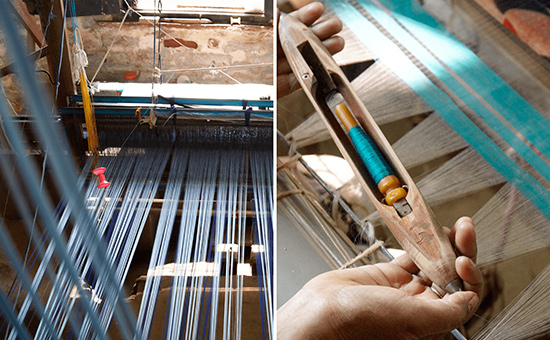 Warp (on left) and weft (on right).
Credit REHWA Society.
Warp (on left) and weft (on right).
Credit REHWA Society.
Chanderis are more
delicate, fine and sheer than Maheshwaris. There was a time when the textile
was compared to Dhakai Muslin and called woven air due to its sheerness. The
texture of Chanderi is more papery while Maheshwaris are softer in texture and
feel. Arguably, Maheshwaris are easier to drape & carry, more comfortable
and low maintenance than Chanderis.
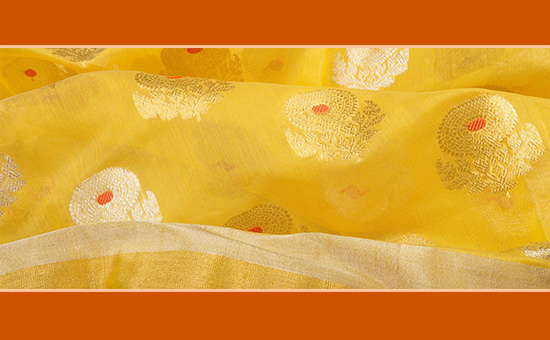 The sheer texture of Chanderi sarees. Credit
kantakala.com
The sheer texture of Chanderi sarees. Credit
kantakala.com
Maheshwaris were, for the longest time,
woven only in pure cotton i.e. cotton yarns in both warp & weft with zari
borders. The mixture of cotton and silk yarns in sarees has been a recent
addition - say 40 year ago or so - owing to the demand for more durable
Maheshwaris, and non-availability of handloom parts required to weave fine
quality pure-cotton Maheshwaris.
Designs in Maheshwaris are
created in the warp i.e. in the borders. When the loom is being set, the design
that will go in the border is set then itself using a dobby mechanism placed on
the top of the loom.
To check-out how
the border is set on the dobby mechanism in Maheshwari sarees, see this short video
by REHWA Society here
While in Chanderis, the designs are
created using extra yarns - almost like embroidery on the base of the textile -
in addition the border in the warp. This is called extra-weft weaving technique
where the weavers manually insert the motifs in the body of the saree using
their bare hands. This extra-weft design is called a butti or buta. Textiles
like Jamdani, Paithani and Benarasi are also woven using this technique.
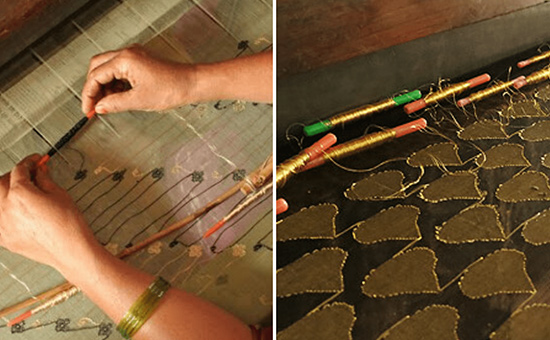 Observe image to understand extra-weft weaving process of Chanderis. Cr Fakingnews.com
Observe image to understand extra-weft weaving process of Chanderis. Cr Fakingnews.com
4. The Borders & Buttis
In Chanderis, the entire burden of design is carried by the extra-weft buttis. The borders are often very simple with buttis lending most to the design.
On the contrary, in
Maheshwaris, the border of the saree plays the most crucial role in design.
Maheshwaris are known for their simplicity - with classic borders along the
saree and in palla. Maheshwaris DO NOT have buttis in the body. The body is
either plain, checkered or striped. The palla, however, can have buttis, albeit
rarely. Even if there are buttis in the palla, their design is restricted to
geometric shapes like circles or triangles.
The buttis, therefore, are the key difference between Maheshwari and Chanderi.
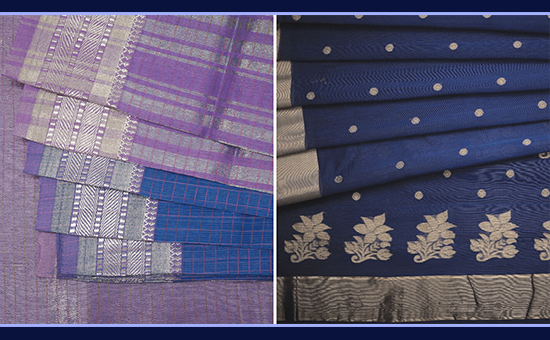 Body of a Maheshwari saree (left) with
an intricate border and stripes, & body of a Chanderi saree with a simple
border but intricate buttis.
Body of a Maheshwari saree (left) with
an intricate border and stripes, & body of a Chanderi saree with a simple
border but intricate buttis.
Picture credit -
REHWA Society and Chanderiyaan.net
The motifs in Maheshwaris
are more geometric. In Maheshwaris, when we say motifs, we mean the border. The
borders in Maheshwari sarees draw heavily from the Ahilya fort in Maheshwar and
countless natural elements found in Nimar region, Madhya Pradesh is where the
town of Maheshwar is located.
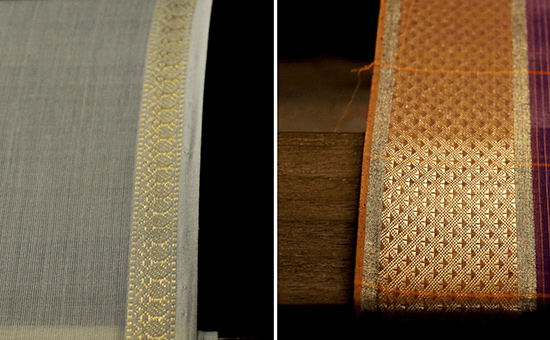 Borders of Maheshwari sarees-Kairi & Diya. Credit Rehwa Society.
Borders of Maheshwari sarees-Kairi & Diya. Credit Rehwa Society.
For example, we see Narmada border in Maheshwaris inspired by the
Narmada river, similarly Laher border - again derived from the river, Rui-phool
border inspired by the cotton plantations in Nimar (as Nimar is a major
cotton-producing region of Madhya Pradesh), Chameli-phool border inspired from
the carvings at the Ahilya Fort and so on.
It is believed that Ahilya Bai, the queen of the Holkar kingdom of Malwa,
herself had painstakingly designed each of these borders. She brought skilled
weavers from different parts of India and gave birth to Maheshwari textiles. It
is her aesthetic and personality that is reflected in the sarees - simple,
elegant and extremely poised.
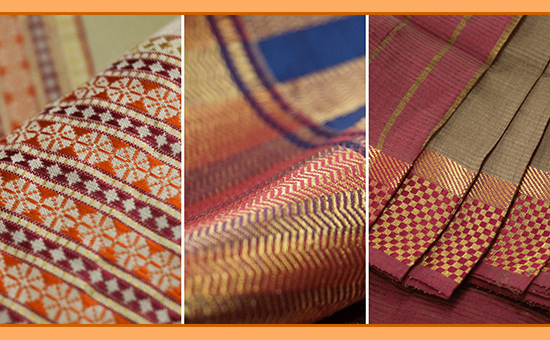 Borders of Maheshwari sarees - Rui-phool, Laher and Eent. Cr Rehwa Society.
Borders of Maheshwari sarees - Rui-phool, Laher and Eent. Cr Rehwa Society.
Chanderi features mostly curvilinear motifs. The design directory here
is dominated by florals, leaves, vines, peacocks, swans, trees, fruits and the
majestic architecture of the Chanderi town. Here comes a similarity between the
two crafts we have been talking about. The design directory of both these
textiles involve heavy usage of natural elements and architectural
carvings.
Some of the most commonly used motifs in Chanderi sarees are ashrafi or gold
coin, churi, bundi, keri, phul-patti, phul-buta, akhrot, paan, eent,
surajbutti, meenabutti, kalgi and ghoongra, nalferma, dandidar, chatai, jangla,
mehndi wale haath. After looking at various motifs, it is safe to say that
Chanderi designs have a considerable Mughal influence.
As mentioned before, Chanderi designs do not rely on borders. The borders are
fewer in comparison to Maheshwaris, they are - Nakshi, Adda, zaripatel,
piping border etc.
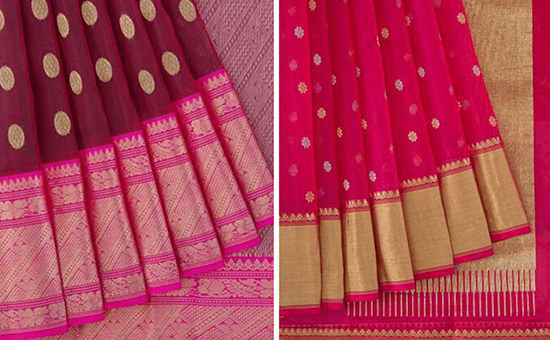 Borders of Chanderi sarees. Credit Nalli Silks.
Borders of Chanderi sarees. Credit Nalli Silks.
Another interesting thing worth mentioning
about Chanderis is that the usage of bright, vibrant colours like magenta,
orange, fuchsia is a newborn phenomenon. Until 50 years ago, Chanderis were
woven in pastels and tones of off-white with sarees being dyed in natural
colours like saffron after it was fully woven. Maheshwaris, however, always
knew bright colours.
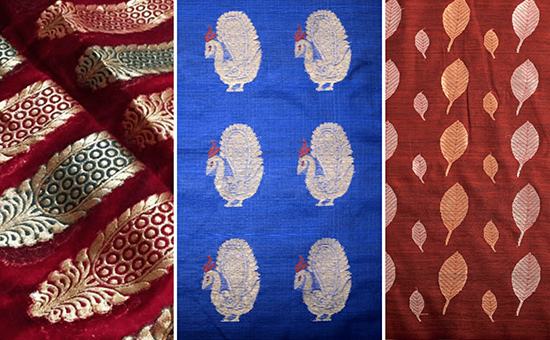 Motifs on Chanderi sarees - Kairi, Mor & Patti.
Motifs on Chanderi sarees - Kairi, Mor & Patti.
Credit - Craftsvilla.com and Chanderiyaan.net
How to identify authentic handloom Maheshwari
and Chanderi sarees?
When looked closely, handloom products will always have some weaving
irregularities, discrepancies. If it looks too perfect, it is most likely a
power loom or factory made product.
Handloom Chanderi sarees are not overly lustrous. They will have a subtle shimmer to it. If the saree is too shiny and bright, it’s not an authentic handloom piece. Same goes for Maheshwaris.
Handloom Chanderis are papery but
neither extremely stiff nor extremely soft. The saree drapes really well
because of the appropriate balance between stiffness and softness. Maheshwaris,
on the other hand, are extremely soft but not slippery. The saree will not slip
or slide and will drape perfectly around the curves of the body.
Always flip and look at the other side
of the textile. You can clearly see and feel how the extra-weft buttis are
woven in Chanderi sarees - almost like embroidery - bulging slightly. In
machine-made sarees, such clear distinction is not possible.
Most Maheshwari textiles are
reversible i.e. they can be worn from both sides. Flip the textile, and you will
find the exact woven border design. Again, in non-handloom sarees, such
precision is very difficult to achieve.
Upon taking a closer look, you can see
the warp and weft yarns forming a pattern in these textiles - really fine
checks juxtaposed together to form the piece. In non-handloom, you cannot make
out the pattern very clearly.
Where can you shop authentic handloom
Maheshwaris and Chanderis?
Thanks to the internet and e-commerce, there are plenty of platforms selling
authentic textiles online these days, in addition to government-run physical
stores. Here is a comprehensive list of such online and offline avenues -
REHWA SOCIETY for Maheshwaris - REHWA Society is a 40 year old
non-governmental organisation based in Maheshwar, Madhya Pradesh. The
organisation is run and managed by the Holkar family, the descendants of
Ahilyabai Holkar herself.
Inaugurated in 1979, when the Maheshwari craft was on the verge of
extinction, REHWA is responsible for reviving the craft and restoring it to its
original glory. They work with 68 weavers - providing them sustainable
livelihood, suitable working environment, healthcare and education.
REHWA has one of the best quality of Maheshwari textiles in the country.
They offer a wide, versatile array of Maheshwari sarees, dupattas, scarves,
fabrics and shawls in both traditional as well as contemporary layouts. You can
shop online through website and Instagram or visit their store cum weaving unit
in Maheshwar. By buying from REHWA, you are supporting a good cause.
Chanderiyaan for Chanderis - Chanderiyaan.net is an e-commerce platform operated by a cluster of Chanderi weavers in collaboration with a Delhi based NGO ‘Digital Empowerment Foundation’. Their products are 100% authentic and still retain the classic, traditional elements of Chanderi craft. By buying from here, you are supporting a good cause.
Raw Mango for Chanderis - Raw Mango, a
high-end fashion brand by designer Sanjay Garg, is known for its luxurious
Chanderi sarees. If you have a good budget, you can definitely shop from Raw
Mango.
Tana Bana for Maheshwaris - Tana Bana is another
set-up based in Maheshwar making fine quality Maheshwari sarees. You can reach
out to them on Facebook to shop their products or visit their store in
Maheshwar.
Roots Handloom and Ecoloom.com - Two more producers
cum sellers of authentic handloom Chanderi and Maheshwari sarees. You can shop
online through their respective websites or Instagram pages.
Mriganaynee is a Madhya Pradesh
government undertaking dedicated to showcasing and marketing authentic handloom
products from weavers of Madhya Pradesh. You can shop online or visit their
stores across the country.
Cheaper, mill-made versions of Maheshwaris and Chanderis have flooded the
markets, and pushed authentic textiles to a far corner. As consumers, producers
and sellers, we must liberally espouse authentic textiles and bring them back
to light. We sincerely hope this article helps us achieve that.
References are three websites ie craftsvilla.com, rehwasociety.org and chanderiyaan.net . Cover pic credits Mptourism.com
Author is a handloom and textile enthusiast based in Indore, Madhya Pradesh.
See
albums of
1.
Maheshwari
Saris Maheshwari
2.
Paithani
Sarees Aurangabad
3.
Sualkuchi
Sarees Assam
4.
Bhujodi
Weaving Kutch